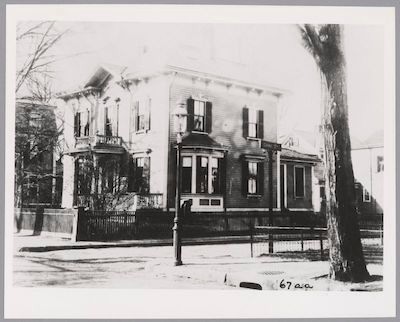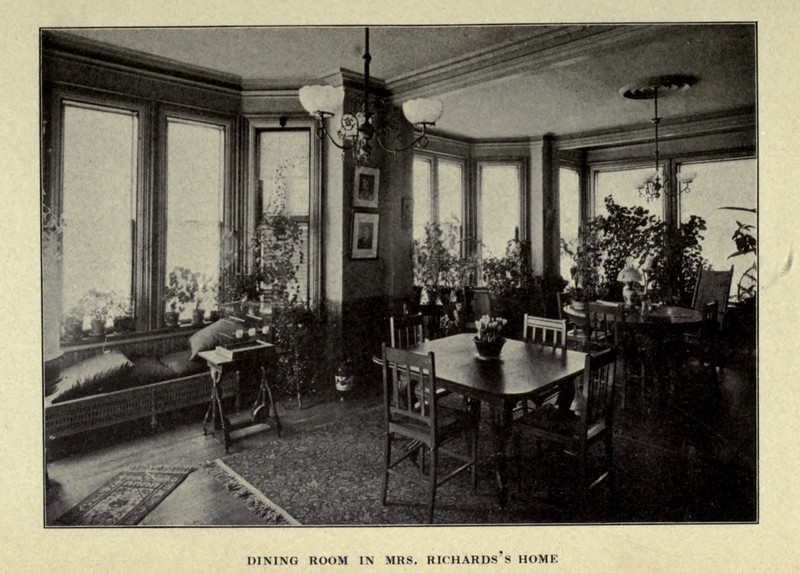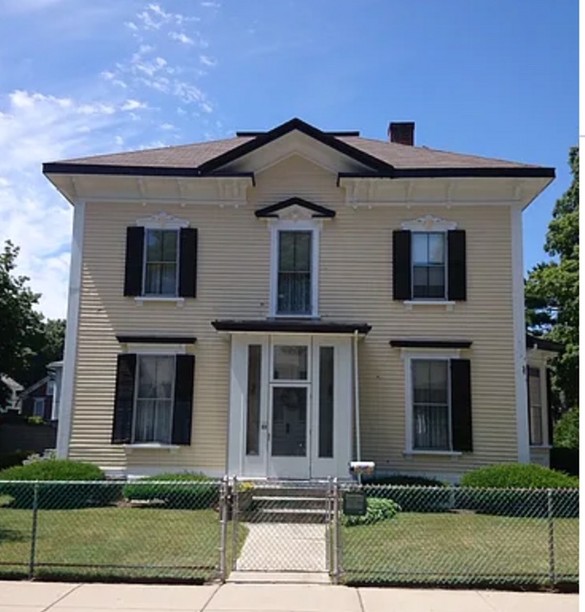Home of Ellen Swallow Richards from 1875-1911
Introduction
Text-to-speech Audio
32 Eliot St. in Jamaica Plain, MA was the home of Ellen Swallow Richards from 1875 until her death in 1911. Ellen was the first woman admitted and graduated from MIT. She married Professor Robert Richards in 1875. As Ellen was an instructor in sanitary chemistry and also a proponent of “ The Art of Right Living”, she was determined that her home become a living, scientific laboratory. Upon her death, Robert remarried and lived in the home until his death in 1945. For 70 years, this home was a scientific experiment like none other. In 2023, the home is under private ownership.
Images
Ellen Swallow Richards House on Eliot St. in Jamaica Plain, late 1800s. View from side street

Dining Room in Mrs. Richards House

Eliot Street Exterior

Eliot Street Exterior - date

Backstory and Context
Text-to-speech Audio
When Ellen and Robert first married, his first inclination was to live in Back Bay, near the early campus of MIT. Ellen would have none of it as she had lived in the vicinity during her undergraduate time at MIT and knew how unsanitary city living was. She insisted they live further outside Boston proper so they could have a home with 4 sides with windows on all sides where air could circulate throughout the house. The house at 32 Eliot St. in Jamaica Plain was perfect for her requirements and could be reached from Boston initially by horse-drawn trolley car and then eventually by electric rail car (1889).
To fully appreciate 32 Eliot as a scientific laboratory in 1875, one needs to define some context. Homes had no electricity, no modern-day appliances such as refrigerators or automatic washers and dryers, no dishwashers, no telephones, and certainly no fiber optic internet. Nearly every appliance, including lighting, was powered by gas or steam. Ellen systematically organized her household for the greatest efficiencies as well as the greatest health and safety. To meet all of these requirements, Ellen instituted some amazing features, highly unusual for the late 19th Century home.
She eliminated heavy curtains/draperies and most of the rug floor coverings as both treatments just trapped dust and allergens. This effort was quite the opposite of most Victorian-style homes of the day. She tended to many green plants which were known to purify the air and provided some sense of privacy at the windows. She placed vents above each of the gas lights on the chandelier to carry out toxic gas fumes. She made sure windows opened at the top to let air escape and circulate. Her gas range was fitted with a hood to remove toxic fumes.
She provided meticulous data about how much it cost to cook/prepare various food dishes, using different techniques. She did employ some domestic help and often housed MIT students who were tasked with certain domestic chores to keep her home running smoothly. She entertained often and students were assistants as well as guests.
Although the mechanical icebox did not arrive until after her death and the electric refrigerator was not readily available until the early 1940s, Ellen most likely made the most of her icebox, in spite of how messy they were. Groceries had to be purchased and used quite readily, sometimes on a daily basis.
Another consideration that has not been written about Ellen’s home is running water and indoor plumbing. Most American homes did not adopt indoor plumbing until after the beginning of the 20th century. This was after cities had expanded with proper water and sewage systems installed. Since Ellen was a sanitary chemist, she certainly would have explored every avenue to guarantee that her home used the best sanitary practices. Much of the indoor plumbing was dependent on towns having a sanitary sewer system and 32 Eliot St was very suburban Boston, so would have most likely developed this system later than downtown Boston. In her book on Euthenics, she quotes the first law of sanitation- “remove all waste.”
One of the best descriptions of having spent time in Ellen’s home at 32 Eliot St is derived from the Purdue University archives which house the collection of A. A. Potter, former Dean of Engineering and a student of Ellen’s 1899-1903. In retirement, he was often asked to give presentations on what it was like to know Ellen Richards and to be entertained as a student in her home.
Sources
- Hunt, Caroline Louisa, 1865-1927. The Life of Ellen H. Richards. Boston: Whitcomb & Barrows, Boston, 1912. https://hdl.handle.net/2027/uc2.ark:/13960/t3513ww21.
- Richards, Ellen Henrietta Swallow, 1842-1911. Euthenics, the science of controllable environment. Whitcomb & Barrows, Boston 1910. https://archive.org/details/euthenicsscience00richrich/mode/2up. Accessed 21 Apr. 2023.
- Talks by A. A. Potter, 1949-1975, Box: 24, Folder: 4. Andrey A. Potter papers, MSF 527. Purdue University Archives and Special Collections. https://archives.lib.purdue.edu/repositories/2/archival_objects/12422. Accessed 20 Apr. 2023.
1. “Ellen Swallow Richards House on Eliot St. in Jamaica Plain.” Courtesy of the MIT Museum. https://mitmuseum.mit.edu/collections/object/GCP-00024248. Accessed 21 Apr. 2023.
2. "Dining Room in Mrs. Richards House." From Caroline Hunt, 1912 (see above)
3. Photo Courtesy of Joyce Mills
4. Photo Courtesy of Joyce Mills
